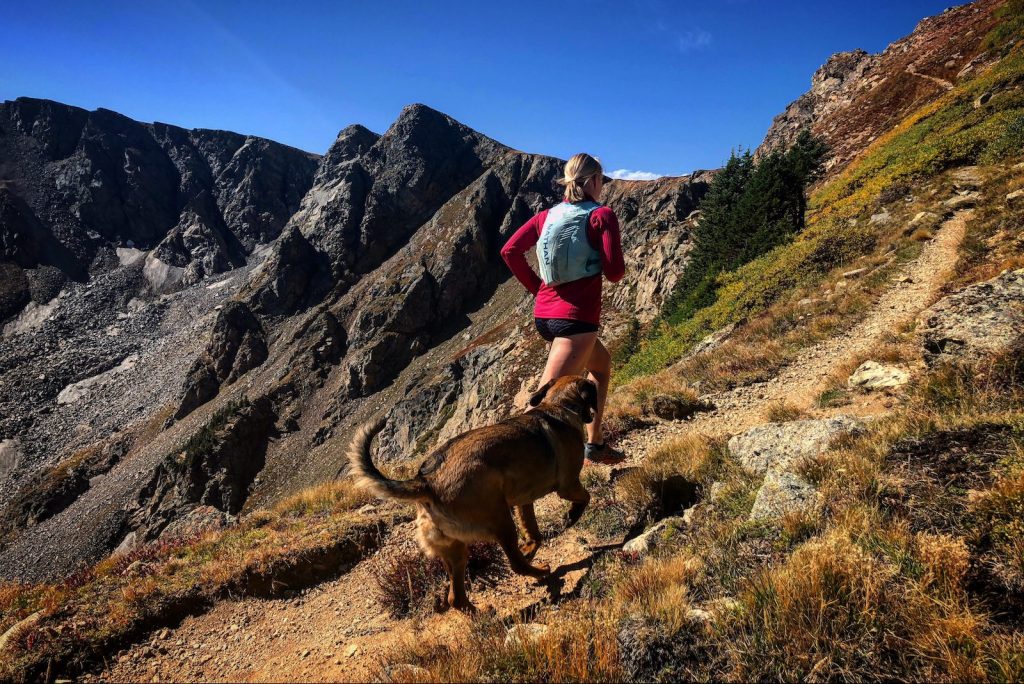Main Menu
Running and Hiking with Dogs

Taylor is a runner, skier, and outdoor adventurer living in Colorado. She discovered the joys of running a few years ago as a way to overcome depression and live a healthier lifestyle. When not running or exploring the outdoors, she works as an emergency veterinarian at VRCC in Denver, CO.
Share This Article!

As a veterinarian, I often get asked for tips about being active with your dog. Currently, I don’t have a personal dog that I run with, but I do have some tips for the basic health of your dog on the trails and roads. Below are a few issues you might run into on the trail.
Heatstroke:
Unfortunately, heatstroke occurs relatively frequently and it can result in death. The main way that dogs dissipate heat is through panting. They can also lose a little bit through their paws and by placing themselves in contact with cooler temperatures (lying on the cool ground, getting in a lake, etc). They cannot sweat like we do and are more prone to overheating. In some cases, animals have underlying conditions that will predispose them to heatstroke and these conditions are not always immediately obvious to an owner. The biggest ones we see include brachycephalic conformation (smashed face breeds), heart conditions, laryngeal paralysis (dysfunction of the larynx resulting in a narrowed airway opening), tracheal collapse, exercise without acclimation, old age, and obesity.

Heatstroke triggers an inflammatory response in the body leading to multiple organ dysfunction. As body temperature rises, damage occurs to the muscles causing them to break down which can also damage the heart, liver, kidneys and gastrointestinal tract. Heatstroke can also interfere with blood clotting, cause significant electrolyte abnormalities, and potentially sepsis.
Heatstroke often presents with listlessness, collapse, excessive panting, hypersalvation, vomiting, and/or bloody diarrhea.
If you are concerned that your dog may be suffering from heatstroke, it is important to start gradually cooling them as soon as possible. Be careful not to cool them too aggressively as this can cause further problems. Spray your dog with cool (NOT COLD) water and drive to the nearest veterinary hospital with the A/C on or windows open. Veterinary intervention will be required as soon as possible.
Heatstroke is most often seen in the spring and summer. If it is hot or humid outside do not bring your dog with you or go on a very short walk. It is so much safer to leave them at home than risk heatstroke. If you are out and you notice your dog starting to lag behind, excessively pant, trying to stop, etc., this is a sign they need a break, pay attention to it. The Swamp Cooler from Ruff Wear can also help keep your dog cool in some situations.
Allergic Reaction:
Allergic reactions occur when animals are bitten or stung by an insect or encounter a plant or another object they are allergic to. The most common clinical signs include a sudden swelling of the face (most often symmetrical and involving both sides of the face), hives (seen as small areas where the fur is standing up), and itchiness. The swelling can be severe in some cases, but this is generally not life threatening unless it interferes with your pet’s breathing. If the swelling does not start to improve on its own, intervention through a veterinarian will be required. In most cases, an injection of a steroid and antihistamine will stop the reaction and improve the clinical signs.
Allergic reactions can be more severe with an anaphylactic reaction. For dogs, the shock organ is the liver which is different than in people, therefore GI signs are the major indicator of an anaphylactic reaction. You can see a sudden onset of diarrhea, drooling, vomiting, collapse, pale gums, and neurologic signs. As in people, this is a medical emergency that requires immediate professional intervention. Unfortunately, there is not a lot that can be done without veterinary intervention. If your dog is known to have severe allergic reactions, in some cases Epi-pens can be prescribed. Talk to your veterinarian about this if your dog has a history of allergic reactions.
Cut and Burned Paws:
Paw lacerations are a very common injury and can occur for a number of reasons. In Colorado, lawn edging is the most common culprit. On trails, if there is a lot of rocks, scree, or scrambling your dog’s pads are at risk. If they are accustomed to this terrain, the risk decreases but is still a possibility. Long distances over trails (or asphalt) can also cause paw wounds. Gradual introduction of increasing amounts of activity can decrease some of these issues. The use of booties to cover the feet in certain terrain can protect your dog’s paws from some of these injuries.

Burns of the foot pads occur less commonly than lacerations. In the summer, it is shocking how hot the concrete and asphalt can get. While this may not be obvious to us because we are wearing shoes, it can absolutely burn your dog’s pads. Surprisingly, dog’s often do not show that they are hurting until it is too late. If it is hot and sunny be aware of pavement heat, especially over long distances or let your dog walk on dirt or grass instead.
In the winter, ice is a major culprit for causing foot injuries. Ice can be surprisingly sharp and cause lacerations. The edges on skis and snowboards are also sharp and can easily cause lacerations. If you ski with your dog, do not allow them to get too close to you on the downhill and watch out when they jump on top of gear in the car.
Snake Envenomation:
Depending on where you live, venomous snakes can be an issue. In the United States, the most common poisonous snakes are coral snakes and pit vipers, with rattlesnake bites being the most common.
In situations in which the snake bite is witnessed, this is extremely helpful in diagnosis. In some instances, it is unclear whether a snakebite has occurred. With pit vipers, a bite will cause sudden severe localized tissue damage including severe swelling, discoloration, and pain. Often fang marks are not visible. With coral snakes, you will see almost no swelling or pain but instead significant weakness and difficulty walking, drooling, shallow breathing, muscle twitching, and collapse.
A snakebite is a medical emergency requiring immediate veterinary attention. Unfortunately there is not a lot you can do in the field other than keeping your dog quiet and limiting its activity on your way to the nearest emergency facility. If the bite was not witnessed, further testing and evaluation at a veterinary facility can elucidate the cause of the clinical signs.

Prognosis for dogs is generally good with early and aggressive treatment and antivenin. There is a rattlesnake vaccination available through your veterinarian. There is poor evidence for efficacy at this time. Rattlesnake deterrent classes are available in some areas to help teach your dog not to bother snakes.
Animal Attacks:
Animal attacks can also be seen both from wild animals or from another dog. Wild animal attacks are not very common but do occur on occasion. The severity of the attacks can be variable from minor to life threatening. In these situations, it is important to protect your dog and yourself. Any animal (or person) who is in immense pain can become combative and violent. With fractures or wounds, any animal can bite without warning if you move them into an uncomfortable position. Protect yourself first with a muzzle (a makeshift muzzle can be made out of anything you can tie around the snout). If there is bleeding, application of bandages can help if you have bandage material available. Use of an article of clothing such as a t-shirt to cover the wound may help prevent further contamination. DO NOT give your dog human medications, as they can cause GI issues, kidney, or liver failure. Bring your dog to the nearest veterinary hospital as soon as possible for evaluation.
Musculoskeletal Injuries:
Dogs can suffer from many of the same injuries that active people do including torn cruciates, strained muscles or ligaments, and fractures. Generally, these are unexpected accidents that cannot always be easily prevented.
As with people, acclimation and training are important in injury prevention. Your previously sedentary dog cannot jump off the couch and run a 10k. Injury is far more likely if you take a sedentary dog and try to push them physically. Gradually introduce activity as you would for yourself. Don’t forget that they want to please you and will not immediately tell you if you are pushing them too hard. Keep in mind too that just because you have a dog whose breed is typically considered active, that does not mean that your specific dog will enjoy physical activity.

If your dog suffers an injury that results in significant lameness or an inability to use the leg while out on the trail, slow down and do your best to help them. A makeshift sling around their chest or abdomen can be made from a long sleeve shirt or towel. Most dogs can do well on three legs, although larger breeds have a hard time with this. As mentioned above, protect yourself first in the case of a severe injury.
Training, Leashes, Etc.:
Proper training is a key component to a positive relationship with your dog in all capacities. On the trail, leash training is obviously key to prevent injury to yourself. In some areas, you can take your dog off leash. This is a great tool when used properly. A significant amount of training is required to make sure that your dog is able to be off leash safely. The last thing you want is to have your dog run off after another dog, person, wild animal, etc. Before you take your dog off leash on the trail, ensure that they have consistent and reliable recall in any situation and that they pay attention to you above all else. Training classes can be integral in this capacity. The more out of control your dog is, the more likely it is that an injury will occur. It is also important to remember that just because your dog is friendly, that doesn’t mean that the approaching dog is also friendly. Be careful with introductions on the trail.
Activity also needs to be slowly introduced to puppies. Small and medium breeds should not be exercised significantly until at least 6 months of age and large breeds until 1 year. This gives their bones, muscles, and connective tissue the time required to mature for long term health.
Water, Food, Etc.:
As an endurance athlete, you know how important fueling is to performance, don’t forget about your dog in this capacity. Bring extra water and a bowl in addition to food or treats. Some companies like Zuke’s make endurance dog treats that can help them make it through long days with you.
Including your dog in exercise and on the trails is a wonderful thing, most dogs love to be out on the trails! With proper training and attention to your specific dog, this can help your relationship with your canine companion flourish!
About the Author

Taylor is a runner, skier, and outdoor adventurer living in Colorado. She discovered the joys of running a few years ago as a way to overcome depression and live a healthier lifestyle. When not running or exploring the outdoors, she works as an emergency veterinarian at VRCC in Denver, CO.
Share This Article!




















One Response
Great information Taylor, thanks! I shared this on my facebook page.